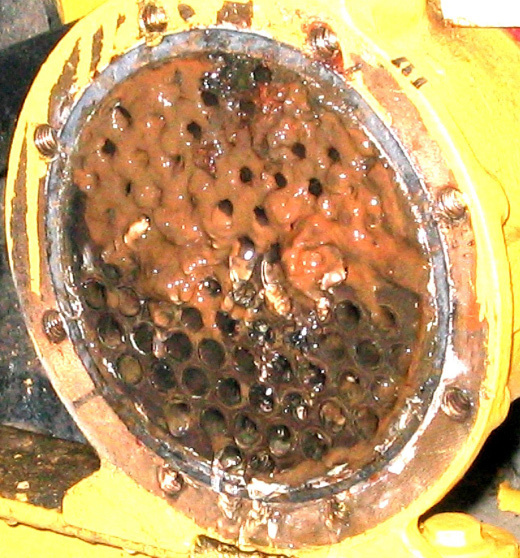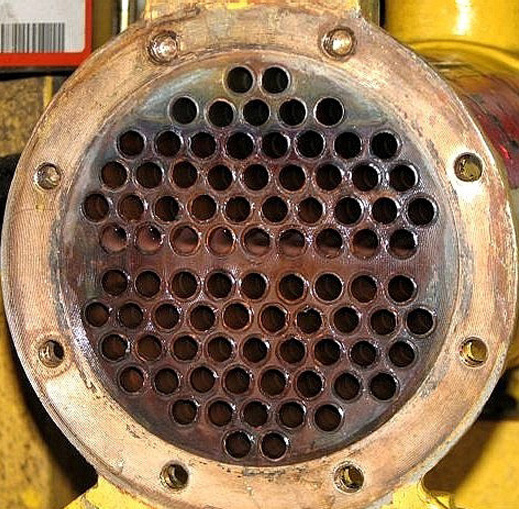Background
Microbiologically facilitated corrosion in closed cooling systems has become more of a concern due to the nature of pitting corrosion cells protected by slimes and cemented crusts. While biocides may effectively control the overall bacterial counts, the protected environments provide a setting for localized corrosive and electrochemical attack. These sheltered reservoirs permit re-inoculation of the system, renewing the problem cycle.

Condensate booster pump heat exchanger before cleaning
Description
Westinghouse has developed a two-phase approach to combat reactor cooling system biological fouling. The first phase employs an oxidation step that kills the majority of the organisms responsible for the biofouling. An additional benefit is the decomposition of a large fraction of the protective biomass, permitting unimpeded solvent access of the second phase of the cleaning to the metallic corrosion products beneath. The second phase uses chelating agents in a reducing environment to decompose and remove typical cooling water scales comprised of inorganic metal oxides and cemented fouling detritus.
The oxidation step includes alkaline permanganate (AP) and BiOX-2 – an alkaline hydrogen peroxide application. Both oxidation processes begin with circulating a solution of NaOH with heating to slough off and decompose most of the organic biomass. Frequent filter changes are performed during the ensuing contact time.When filter change intervals become infrequent, an oxidizing agent, either AP or BiOX-2, is introduced into the system. When the majority of the organic components have been oxidized either to CO2 or to another shorter chain organic species, the system can be drained to industrial waste, or cleaned up on ion exchange to a suitable water quality, and the step is considered complete.
The reduction and chelation step can consist of dilute oxalic acid alone, or combinations of citric, oxalic and ascorbic acids to provide reducing conditions plus chelation capability to decompose the remaining inorganic scale and organic detritus. The reductive process can be regenerative when oxalic acid is employed, as cation ion exchange removes metallic materials and regenerates the hydrogen ions necessary to drive the dissolution reactions. Applications using ascorbic acid are non-regenerative. The solvent contact duration primarily depends on system loading and our experience has shown that there are no deleterious effects to system materials, even with extensive solvent application durations. It has also been shown that a protective passivation layer of black iron oxide routinely forms. Analysis of samples for dissolved iron provides indication of when the reductive process is complete. At that time, the system is drained to industrial waste, a rinse is performed, and to complete the process, ion exchange is used to clean up the system inventory to suitable water quality.
During the process, corrosion tendencies are monitored by a CORRATER® linear polarization resistance unit while employing the two most susceptible materials of construction as working electrodes. Several corrosion coupons are routinely installed into the system for additional measurements of differing materials.

Condensate booster pump heat exchanger after cleaning
Benefits
The Westinghouse chemical cleaning process for biologically fouled systems is a proven process that:
- Kills the organisms responsible for the bio-fouling
- Decomposes the protective biomass
- Decomposes and removes typical cooling water scales
Experience
Westinghouse has successfully applied these processes to cooling systems at several nuclear plants since the early 1990s.
CORRATER is a trademark or registered trademark of its respective owners. Other names may be trademarks of their respective owners.













